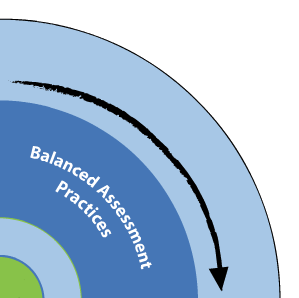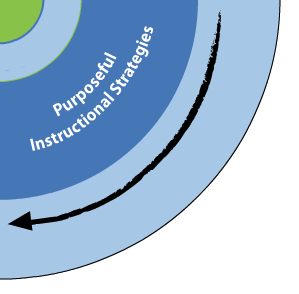Expression
Page Navigation
(Click to jump to section)
| Brief Explanation | Research | Characteristics of a Skilled Reader | Clearly Identified Key Outcomes | Balanced Assessment Practices | Purposeful Instructional Strategies | Personalization of Learning |
Brief Explanation
Reading with expression includes the application of appropriate patterns of expressive features (rhythm, intonation, and phrasing). Fluent readers are able to read a text accurately, smoothly, quickly, and with expression.
Research
Students who read fluently have developed word automaticity and understand how to group words quickly to gain meaning from the text (Tankersley, 2003). Students need to hear how a fluent reader sounds and how he or she uses expression and phraseology to help make meaning out of the words (Tankersley, 2003). Intonation, stress, and phrasing help the readers chunk the text into syntactically appropriate units.
Characteristics of a Skilled Reader
With
Increasing
Sophistication
- Group words into phrases that promote understanding
- Read with appropriate pacing, intonation and expression
- Combine multiple tasks while reading (e.g. decoding, phrasing, understanding and interpreting)

Clearly Identified Key Outcomes
Use your programs of study for curriculum outcomes related to expression.
Please refer to CESD’s Essential Outcomes work if you are using the previous Alberta Curriculum (Grade 7+).
Here is the New Alberta ELAL Curriculum, from the New Learn Alberta website, laid out like a scope and sequence.

Balanced Assessment Practices
- As a teacher, how could I assess phrasing, stress and intonation in my students?
- Assessment of fluency should include rate, accuracy, comprehension and expression (adapted from Barclay, 2011). See the comprehension section of this framework for further assessment strategies related to comprehension.
- Use running records and record phrasing using slash marks
- There are a variety of tools and resources available for tracking and assessing phrasing, stress and intonation as components of fluency. Check with your school to see which tools are being used. The following tools are currently being used throughout Chinook’s Edge (this list is by no means exhaustive):
- Multidimensional rubric for assessing fluency: expression and volume, phrasing and intonation, smoothness, pace (Rasinski and Padak, 2005, p. 11).
- Norms are available providing number of words per minute expected at different times at different grade levels and with accompanying percentile scores. (Reithaug, 2009, p. 220)
- Level A assessment tools and other texts of known levels.
- Understanding and Assessing Fluency -Reading Rockets
- Fluency Rubric-Tim Radinski

Purposeful Instructional Strategies
PRE
- Model ‘fluent reading’ (accuracy, speed, phrasing, expression) on a regular basis. Regardless of the grade level, students need to know what fluent reading sounds like.
- Develop students’ background knowledge on the topic of the text and connect to prior knowledge.
- Pre-teach vocabulary and text features
- Preview texts and pre-read
- Fluency goal-setting
DURING
- Provide regular and sufficient time for students to read texts at their independent reading level (96% or higher accuracy rate). Students need to be exposed to a wide variety of texts, and have opportunities to read FREQUENTLY.
- Allow students to reread passages aloud and receive feedback on their fluency (verbal feedback, chart progress).
- Ensure students have opportunities for repeated readings of the same text.
- Shared reading approach: choral reading followed by multiple re-readings of the same book
- Modelling or Echo Reading
- Radio plays: focus on the rise and fall of the reader’s voice, word phrase and grouping strategies
- Different voices for different characters: play same script or lines using with different voices
- Model phrasing: use slash marks in text and ask students to try to read reach word group as a complete set without stopping. Direct instruction in phrasing can help less fluent readers.
- Playing with Punctuation: move punctuation and have students read the sentence with pausing as indicated.
- Reader’s Theatre
- Rehearsal or Performance Reading
- Recorded Reading
- Guided reading: guided and independent practice
- Choral reading: students read along with fluent reader using chart or big book
- Paired reading
- Poetry, songs, raps, rhymes
- Repeated readings of the same, short passage of 100-300 words: chart improvement in reading rate or words read/minute.
- Once the student attends to print, have them stop pointing at words.
POST
- Providing specific feedback that targets rate, expression, accuracy or comprehension – example: segmentation of words, intonation, phrasing, self-monitoring and self-repairing, etc.
- Teacher should plan and strategize to build skills that are lacking until the student has reached or exceeded the desired level, and design purposeful instructional strategies for the student – look at the pre and during sections above for ideas and strategies.
- Encouraging self-assessment and peer feedback
- Tracking improvement with pre and post recorded samples of the student reading
- Fluency goal setting
- Consult with LST, other staff members, etc., for programming ideas to build fluency skills in the student
RESOURCES TO SUPPORT OVERALL DEVELOPMENT
- Levelled classroom books (see Reithaug, D. (2009) Three Tiers of Instruction and Intervention for Reading. West Vancouver, BC: Stirling Head Enterprises Inc., p. 221)
- Have books of various reading levels available.
- High interest/low vocabulary books: see Reithaug, 2009, p. 213 for list of publishers






Personalization of Learning
- Provide choices in reading material and expose students to a wide variety of topics and types of text.
- Reading assessments help to identify individual students who require targeted support in developing fluency and expression.
- The independent reading level for each student identified to ensure students are reading text at 96% or higher accuracy rate.
- Direct and specific feedback.
- Consult with LST, other staff members, etc., for programming ideas to build fluency skills in the student.